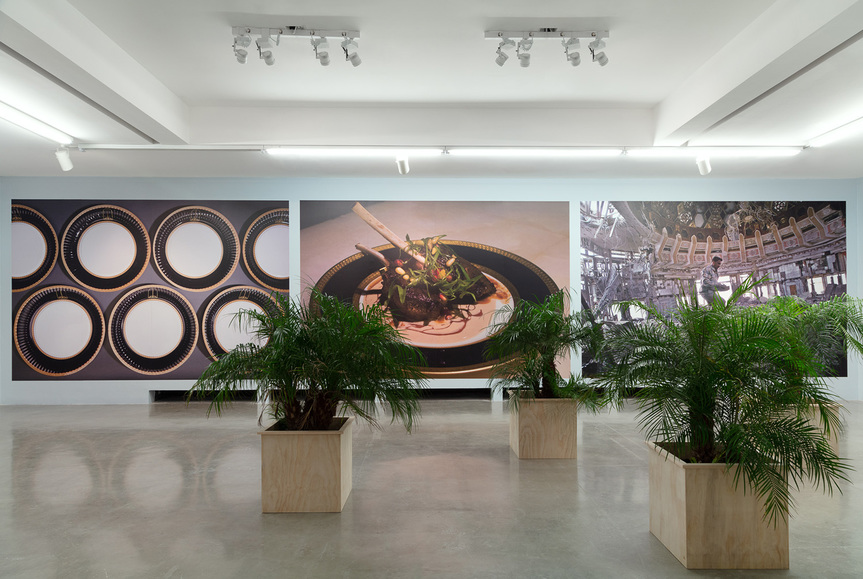-
From Current Issue
-
- Editor’s Letter Fire in the Heart
- Reviews I Gusti Ayu Kadek Murniasih
- Reviews 11th Seoul Mediacity Biennale: “One Escape at a Time”
- Dispatch Networked China
- One on One Monira Al Qadiri on Yukio Mishima
- Essays The rise of independent art spaces in pandemic-era Shanghai
- Features Tuan Andrew Nguyen
- Table of Contents
- Web Exclusives
- Archive
- Subscribe

R
E
V N
E
X
T
Installation view of MICHAEL RAKOWITZ’s “Dispute Between the Tamarisk and the Date Palm” at REDCAT, Los Angeles, 2019. All photos by Brica Wilcox. Courtesy the artist and Rhona Hoffman Gallery, Chicago.
The embattled intersection of Iraq and the United States is the conceptual space that Iraqi-American Michael Rakowitz occupies in his sculptural, installation and time-based performance works. “Dispute Between the Tamarisk and the Date Palm” at REDCAT Los Angeles brought together several of Rakowitz’s ongoing projects, initiated in the past 15 years. One small but important element ties them together—the date in its many forms. Iraq is one of the world’s largest producers of dates, a fruit that has special symbolic resonance for many Middle Eastern countries. Just as the date’s sweetness contrasts with its tough pit, Rakowitz’s poetic works strike a bittersweet tone, shedding light on the unfortunate circumstances of looting, sanctions, and the fractious relations between opposing countries.
Detail installation view of MICHAEL RAKOWITZ’s The invisible enemy should not exist (Room Z, Northwest Palace of Nimrud), 2018, seven reliefs and six missing reliefs, Middle Eastern newspaper and paper packaging, glue, cardboard on wooden structures, artist labels, 8.23 × 5.49 m, at “Dispute Between the Tamarisk and the Date Palm,” REDCAT, Los Angeles, 2019. Courtesy the artist and Rhona Hoffman Gallery, Chicago.
For The invisible enemy should not exist (2007– ), Rakowitz mined the University of Chicago’s Oriental Society databases and Interpol records to identify artifacts from the National Museum of Iraq that have been lost, looted, or destroyed since the outbreak of war in 2003, estimated at over 7,000 objects. Using spliced and cut up newsprint, magazines, and packaging for other everyday consumables from Iraq, Rakowitz recreates ancient vases, votive figures, jewelry and miniatures. Placed on a tabletop with accompanying labels, one inspects these objects as one would exhibits in a museum vitrine. Although made from what could be considered trash, these items are lovingly and meticulously crafted, as if they were spiritual stand-ins or effigies for the real objects. The most striking and heartrending examples are the smaller pieces, which require astute attention from both the maker and the viewer. A Hematite cylinder seal and impression from 2,000–1,190 BCE, for example, reaches no more than a couple of inches tall and could fit in the palm of a hand. Made from fastidiously manipulated paper, likely the pages of an Arabic book, the seal features tiny figures in relief. To its right is the stamped result, depicting a procession of humans and animals. Employing the method on a much larger scale, Rakowitz reimagines a series of towering wall friezes depicting Assyrian winged genies from the Palace of Nimrud—some destroyed by ISIS and others on display at the British Museum and other institutions—in their original resplendent polychrome. In one particular panel, magazine cutouts and food wrappers imitate the regalia of the winged beings. Gold Maggi bullion cube wrappers make for convincing gilded details in a flower branch, sandals and headdress. The vibrant genie stands against a backdrop of red, white and blue waxed bakery paper.
Partial installation view of MICHAEL RAKOWITZ’s Return, 2004– , mixed-media installation with date palms, wood planters, digital color video with sound: 19 min 48 sec, crates, shelf, cardboard box of dates, can of date syrup, can of date molasses, jars of date molasses, date seeds, wall vinyl, artist labels, dimensions variable, at “Dispute Between the Tamarisk and the Date Palm,” REDCAT, Los Angeles, 2019. Courtesy the artist.
Something lost and restored is a frequent theme in the show. Return (2004– ) is a video that tracks Rakowitz’s temporary 2006 reopening of the successful import and export business that his grandfather had established in Baghdad. Exiled from Iraq for being Jewish, Rakowitz’s grandfather relaunched his business, Davisons & Co., in Long Island, New York. Rakowitz’s new store in Brooklyn attempted to import dates from Iraq, a nearly impossible task due to customs hold-ups of merchandise from the sanctioned country.
An unexpected form of return occurred with Spoils (2011), a fine-dining concept featuring recipes using Iraqi date syrup and served on royal dishware looted from Saddam Hussein’s palaces. Rakowitz purchased the china on eBay from two sources: an American soldier who had served in the same brigade as the one that captured Saddam Hussein, and an Iraqi refugee living in Michigan. The project was forced to shut down when the US government got wind of the illicit dishware. A video in the exhibition space shows a US Marshal inspecting the items before picking them up to be repatriated to Iraq.
More utopic and uncontroversial in nature is Enemy Kitchen (2003– ), involving a cooking workshop taught in schools, and a food truck staffed by Iraqi refugees and American veterans of the Iraq War. Represented in the gallery through an installation titled Enemies and Kitchens (2012), composed of objects such as the chef’s jacket that Rakowitz wore, or a napkin box from an Iraqi restaurant, the ongoing project is testament to the idea that food, nourishment and the rituals of dining will bring people together. In his works, Rakowitz seeks equilibrium, peace and understanding, perhaps the kind that ultimately led to his very existence as the child of an Iraqi woman and an American man.
Jennifer S. Li is the Los Angeles desk editor for ArtAsiaPacific.
Michael Rakowitz’s “Dispute Between the Tamarisk and the Date Palm” is on view at REDCAT, Los Angeles, until June 2, 2019.
To read more of ArtAsiaPacific’s articles, visit our Digital Library.



















